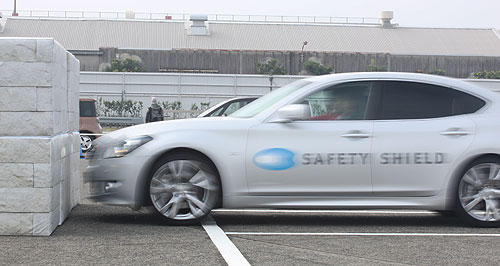News - NissanNissan low-cost warning systems approachWrong pedal: Nissan has developed a system to override pedal misapplication. Affordable new accident-avoidance technologies could greatly reduce death rates12 Dec 2011 By BYRON MATHIOUDAKIS in TOKYO NISSAN is set to offer affordable driver warning technologies that were once the provenance of upmarket luxury brands like the company’s own Infiniti marque, as it attempts to cut the global annual road toll from 1.2 million people. The systems, which serve to proactively detect risks and react before accidents can occur, falls under Nissan’s ‘Advanced Crash Avoidance Technology’ banner and should start appearing in Australia in next-generation vehicles from late next year or 2013. ‘Acceleration Suppression for Pedal Misapplication’ basically uses sonar to detect obstacles, and then automatically applies the brakes to help avoid or mitigate a collision. Working in conjunction with Nissan’s innovative Around View Monitor image processing technology that provides a realistic bird’s eye view of the car’s surroundings via four cameras, Nissan says this tech will be commercialised within the next two years.  Left: AVM cameras.The AVM camera is also handy for detecting people, other vehicles and road conditions immediately behind or beside the vehicle it is fitted to. Left: AVM cameras.The AVM camera is also handy for detecting people, other vehicles and road conditions immediately behind or beside the vehicle it is fitted to.It enables a buzzer to sound an alert and flash a light located on the pillar to a driver who switches on the indicator with the intention of manoeuvring into harm’s way. Similarly, the AVM tech detects white lines so a driver that begins to drift from an existing lane will have both an audible and visual warning activated. Finally, should somebody or something stray behind a reversing Nissan, the AVM’s image processing function will pick it up and immediately inform the driver via yet another buzzer and light display. Lastly, Nissan will install a millimetre-wave radar sensor in the nose of some of its vehicles to analyse – on the move – the speed as well as the gap to the vehicle ahead as part of its Predictive Forward Collision system. Should the space between the two vehicles narrow too quickly, an alarm, light display and seatbelt tightening action all take place simultaneously, prompting the driver to either brake or undertake affirmative action to avoid a collision. Unfortunately, the system does not actually brake the car like many other radar-based cruise control systems, until a collision is absolutely inevitable, in which case the Electronic Brake-force Distribution helps mitigate the impact. There is no indication when this technology might be available in your next Pulsar.  |
Click to shareMotor industry news |














Facebook Twitter Instagram